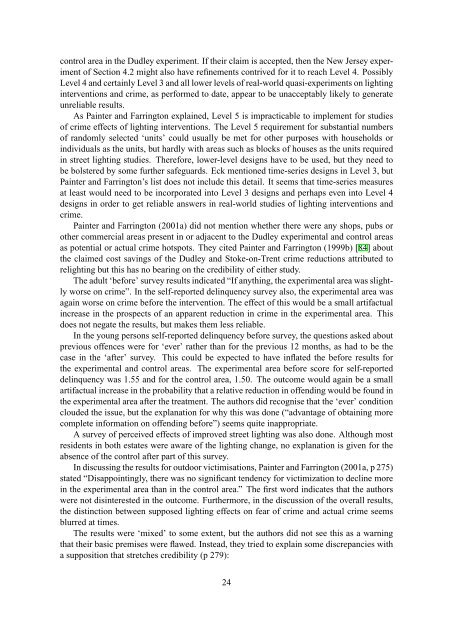outdoor lighting and crime, part 1 - Astronomical Society of Victoria
outdoor lighting and crime, part 1 - Astronomical Society of Victoria
outdoor lighting and crime, part 1 - Astronomical Society of Victoria
You also want an ePaper? Increase the reach of your titles
YUMPU automatically turns print PDFs into web optimized ePapers that Google loves.
control area in the Dudley experiment. If their claim is accepted, then the New Jersey experiment<br />
<strong>of</strong> Section 4.2 might also have refinements contrived for it to reach Level 4. Possibly<br />
Level 4 <strong>and</strong> certainly Level 3 <strong>and</strong> all lower levels <strong>of</strong> real-world quasi-experiments on <strong>lighting</strong><br />
interventions <strong>and</strong> <strong>crime</strong>, as performed to date, appear to be unacceptably likely to generate<br />
unreliable results.<br />
As Painter <strong>and</strong> Farrington explained, Level 5 is impracticable to implement for studies<br />
<strong>of</strong> <strong>crime</strong> effects <strong>of</strong> <strong>lighting</strong> interventions. The Level 5 requirement for substantial numbers<br />
<strong>of</strong> r<strong>and</strong>omly selected ‘units’ could usually be met for other purposes with households or<br />
individuals as the units, but hardly with areas such as blocks <strong>of</strong> houses as the units required<br />
in street <strong>lighting</strong> studies. Therefore, lower-level designs have to be used, but they need to<br />
be bolstered by some further safeguards. Eck mentioned time-series designs in Level 3, but<br />
Painter <strong>and</strong> Farrington’s list does not include this detail. It seems that time-series measures<br />
at least would need to be incorporated into Level 3 designs <strong>and</strong> perhaps even into Level 4<br />
designs in order to get reliable answers in real-world studies <strong>of</strong> <strong>lighting</strong> interventions <strong>and</strong><br />
<strong>crime</strong>.<br />
Painter <strong>and</strong> Farrington (2001a) did not mention whether there were any shops, pubs or<br />
other commercial areas present in or adjacent to the Dudley experimental <strong>and</strong> control areas<br />
as potential or actual <strong>crime</strong> hotspots. They cited Painter <strong>and</strong> Farrington (1999b) [84] about<br />
the claimed cost savings <strong>of</strong> the Dudley <strong>and</strong> Stoke-on-Trent <strong>crime</strong> reductions attributed to<br />
re<strong>lighting</strong> but this has no bearing on the credibility <strong>of</strong> either study.<br />
The adult ‘before’ survey results indicated “If anything, the experimental area was slightly<br />
worse on <strong>crime</strong>”. In the self-reported delinquency survey also, the experimental area was<br />
again worse on <strong>crime</strong> before the intervention. The effect <strong>of</strong> this would be a small artifactual<br />
increase in the prospects <strong>of</strong> an apparent reduction in <strong>crime</strong> in the experimental area. This<br />
does not negate the results, but makes them less reliable.<br />
In the young persons self-reported delinquency before survey, the questions asked about<br />
previous <strong>of</strong>fences were for ‘ever’ rather than for the previous 12 months, as had to be the<br />
case in the ‘after’ survey. This could be expected to have inflated the before results for<br />
the experimental <strong>and</strong> control areas. The experimental area before score for self-reported<br />
delinquency was 1.55 <strong>and</strong> for the control area, 1.50. The outcome would again be a small<br />
artifactual increase in the probability that a relative reduction in <strong>of</strong>fending would be found in<br />
the experimental area after the treatment. The authors did recognise that the ‘ever’ condition<br />
clouded the issue, but the explanation for why this was done (“advantage <strong>of</strong> obtaining more<br />
complete information on <strong>of</strong>fending before”) seems quite inappropriate.<br />
A survey <strong>of</strong> perceived effects <strong>of</strong> improved street <strong>lighting</strong> was also done. Although most<br />
residents in both estates were aware <strong>of</strong> the <strong>lighting</strong> change, no explanation is given for the<br />
absence <strong>of</strong> the control after <strong>part</strong> <strong>of</strong> this survey.<br />
In discussing the results for <strong>outdoor</strong> victimisations, Painter <strong>and</strong> Farrington (2001a, p 275)<br />
stated “Disappointingly, there was no significant tendency for victimization to decline more<br />
in the experimental area than in the control area.” The first word indicates that the authors<br />
were not disinterested in the outcome. Furthermore, in the discussion <strong>of</strong> the overall results,<br />
the distinction between supposed <strong>lighting</strong> effects on fear <strong>of</strong> <strong>crime</strong> <strong>and</strong> actual <strong>crime</strong> seems<br />
blurred at times.<br />
The results were ‘mixed’ to some extent, but the authors did not see this as a warning<br />
that their basic premises were flawed. Instead, they tried to explain some discrepancies with<br />
a supposition that stretches credibility (p 279):<br />
24
















